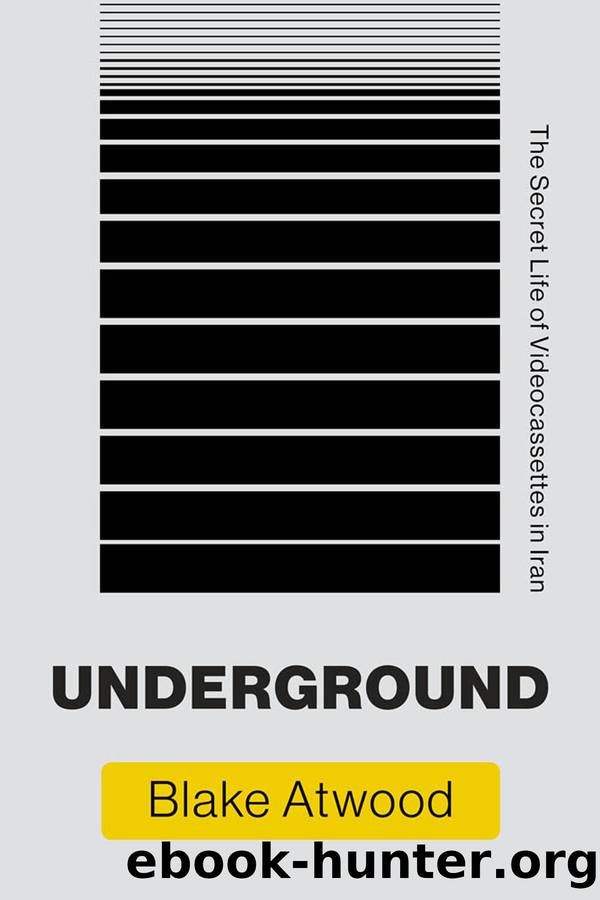Underground: The Secret Life of Videocassettes in Iran by Blake Atwood

Author:Blake Atwood [Atwood, Blake]
Language: eng
Format: epub
Tags: Social Science, history, Iran, video; Iran; informal media; materiality; underground culture; infrastructure; labor; videocassettes; regulation; distribution; oral history; media history, Technology & Engineering, Middle East, Media Studies
ISBN: 9780262542845
Google: nwlAEAAAQBAJ
Publisher: MIT Press
Published: 2021-09-28T00:25:29.360550+00:00
TASTEMAKERS, CURATORS, AND CREATIVE LABORERS
Underground video distribution in Iran forces us to reimagine our understanding of creative work, especially when it comes to media. The idea of creative work inspires images of artisans and bohemians living luxurious lifestyles. In popular imagination, creative workers occupy a vastly different space compared to the quintessential industrial worker in terms of their tastes, class associations, and work conditions.26 Under these terms, it would be easy to dismiss the idea of video dealers as creative workers. Not only did their class associations and work conditions align them with industrial workers, but the work they performed also did not seem especially creative, at least at first glance. Yet video dealers were more than neutral intermediaries or couriers simply transporting material objects. The work they did creating, curating, and circulating videocassettes imbued these commodities with meaning and value. Video dealing required ingenuity as much as it demanded technical and cultural knowledge.
The notion of creativity has been central to how scholars study media labor as well as work within the creative economy more generally. Yet efforts to theorize creative labor have largely been incompatible with discourses on piracy, which position informal media work as the antithesis of creativity. Like the Iranian state in the 1980s and 1990s, todayâs intellectual property rights regimes view informal media distributors as crooksâthe moral enemies of art and culture writ large. In contrast, I argue that video dealers exercised a creativity that helped shape the cultural value of the products they distributed. We can trace creativity not only in the work that video dealers did transporting videocassettes but also in the way they curated and prepared their selections. Such a reading of the work of video distribution blurs clear distinctions between what we consider the original and what we consider the copy.
Although itâs true that video dealers distributed movies outside of formal media industries, the videocassettes they circulated were not just copies. The quality was often highly disparate, but so too was the content. As I show, video dealers played a major role in how a movie was received, embedding it with values and meanings wholly separate from its original production. Both videocassettes and their circulation were the video dealerâs own unique creations.
This argument builds off of a growing body of scholarship that seeks to uncover creative labor in unexpected places and in unusual shapes and forms.27 Despite the diversity of this scholarship, it shares an unbending focus on formal media industries, in which the production of cultureâwhether a movie, a television show, or a video gameâremains the most important objective. One way to extend this line of scholarship would be to propose that illegal video distribution represents creativity within an informal industry, in contrast to scholarship on formal media production. Such a proposition, however, may fall short of adequately accounting for the labor of informal media distribution. As I will show, the work of video dealers was much more complicated, challenging easy distinctions between informal and formal industries and between production and distribution.
Download
This site does not store any files on its server. We only index and link to content provided by other sites. Please contact the content providers to delete copyright contents if any and email us, we'll remove relevant links or contents immediately.
| Automotive | Engineering |
| Transportation |
Machine Learning at Scale with H2O by Gregory Keys | David Whiting(4183)
Never by Ken Follett(3791)
Urban Outlaw by Magnus Walker(3342)
OPNsense Beginner to Professional by Julio Cesar Bueno de Camargo(3251)
Sapiens and Homo Deus by Yuval Noah Harari(2987)
Will by Will Smith(2793)
A Short History of Nearly Everything by Bryson Bill(2629)
Hooked: A Dark, Contemporary Romance (Never After Series) by Emily McIntire(2502)
Rationality by Steven Pinker(2291)
Borders by unknow(2229)
The Becoming by Nora Roberts(2088)
Holy Bible (NIV) by Zondervan(2087)
The One Percenter Encyclopedia by Bill Hayes(1787)
HBR's 10 Must Reads 2022 by Harvard Business Review(1777)
Freedom by Sonny Barger(1771)
A Short History of War by Jeremy Black(1762)
Five Ways to Fall by K.A. Tucker(1700)
Go Tell the Bees That I Am Gone by Diana Gabaldon(1687)
Girls Auto Clinic Glove Box Guide by Patrice Banks(1685)
